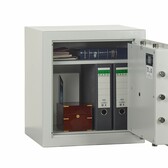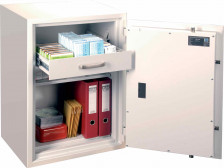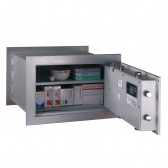We have already written about safes from almost every angle, talked about security classes, locks, fire resistance, even colour and design. But what exactly is a safe and how does it work? We'll look at it with a few examples.
What is a safe and what is not a safe?
A safe is a special type of device that is used to store valuable items such as money, jewellery, documents or weapons. Safes are mostly made of metal and equipped with security mechanisms such as locks, codes, biometric readers or alarms. They are designed to protect the contents from theft, burglary, fire or other threats. Safes can be built into a wall, floor or piece of furniture, or freestanding. They are used by individuals as well as institutions or entities such as banks, shops, hotels or offices. Safes are often divided into classes according to their level of resistance to various factors.
What distinguishes safes from devices that look similar and are often sold as 'safes' are certificates confirming their resistance to burglary, based on the European and Polish standards EN 14450 and EN 1143-1. Therefore, safes are not so-called hotel safes, devices that are not designed to withstand a burglary attempt. A hotel safe is used to store a passport, documents or a camera in. Similarly, there are 'money boxes' on the market, which have absolutely nothing to do with safes.
What does a safe consist of?
As a safe is meant to protect valuables from burglary, its construction and design must be secure. So what does a safe consist of?
Body
The body of the safe, i.e. its walls, are constructed primarily from high-quality steel. The simplest safes in class S1 have a single-wall body. This means that the walls of the safe are constructed from a single 3-6 mm thick steel plate. Such security for your safe will be strictly basic, safes of this class are similar to the hotel safes mentioned above.
In the higher burglary classes, the complexity of the body construction increases. Multi-walled construction means that the wall of the safe consists of several steel plates of different thicknesses, with materials with properties other than steel in between. The spaces between the plates are poured with special concrete to add weight to the safe and make it more difficult to drill.
In the most advanced safes, materials such as sand, special types of resin and ceramic substances also appear. All this is done to make drilling the safe more difficult and longer.
In fireproof safes, a layer of thermal insulation additionally appears, for example from a salt solution, which also has its own properties when confronted with a drill.
Door
The door of the safe is used to open and close it to secure valuables when you are not around. As it is the moving element that allows you to get into the safe, its construction must be particularly resistant to attempted break-ins. The door is therefore constructed just as meticulously as the body, and sometimes more so. Even in lightweight safes it is common to reinforce the door panel with an additional layer of steel, especially in the area of the lock.
The connecting point between the door and the body of the safe are the hinges, which can take various forms.
There are safes with internal hinges, hidden in the body. In this case, the opening area of the safe is limited by a door leaf tilted to a maximum of 90 degrees. Opening the safe in this way is not particularly convenient, but it has its advantages, above all it allows the front of the safe to remain flat. This is useful for small built-in furniture safes and wall safes.
Hinges that lead outwards are heavier, more solid. You can open a safe fitted with such hinges 180 degrees, making it convenient to open, allowing unrestricted access to the interior. Any safe that has hinges of this type has some form of protection in case the hinges are cut from the outside. The most common is either several fixed bolts or a profile that overlaps the door light.
Lock
The lock is a very important part of the construction of any safe. Important to the extent that locks, including electronic locks, have separate safety standards and certifications. It is worth remembering that the lock as such is always underneath the armour plate of the door, while what you see on the outside, be it the keypad, the knob or the keyhole, is the least important part of the lock.
There are several types of lock, however, the choice of lock does not affect the security level of the safe as such.
Safes are fitted with key locks as standard. This is not a particularly convenient solution, as the key is usually long and bulky (the higher the class, the longer the key). As a rule, there are two keys per safe. An interesting solution is the mechanical combination lock, i.e. the good old dial. A lock with character no doubt, but requiring patience and precision. The most common choice, however, are electronic locks, whose operation is simple and intuitive. If you want convenience and speed, choose this one. An electronic lock runs on a battery that can be replaced approximately every two years.
There is a lock that allows you to open the safe using an app installed on your smartphone. This solution is interesting and convenient, but bear in mind that the lock is not certified as burglar-proof and therefore the entire safe will not have one.
Locking system
Although it seems obvious, the locking system of a safe is crucial. One thing you need to know about bolts: their quality and durability determines whether or not the door will resist a breakout attempt. In order to keep your valuables safe in your home, you need to ensure that what is meant to be locked stays locked, and it is on the bolts that much of the burden of this task rests.
In a modern burglary safe, the bolting is always multilateral. This means that the bolts extend from several sides of the door: from the top, from the bottom and along the vertical edge. The number of bolts varies depending on the size of the safe; in compact safes, which are more like a hotel safe than a cash-box, there are usually one, maximum two bolts per side.
Also important is the thickness of the bolts themselves, which increases with burglary protection class and can be up to several centimetres in diameter. The bolts also come in different shapes. The vast majority of safes have cylinder-shaped bolts, yet there are also some bar-shaped ones.
The locking system is set in motion mechanically by physically turning the handle on the door. Personal human intervention is therefore required to open the safe.
What does it look like to open a safe in an emergency if you forget the combination to it?
One of the most common questions about operating a safe is: what happens if you forget the code? The possibilities, as in life, are at least two.
As long as you are dealing with a safe that is about 50 cm wide, it is possible to equip the electronic lock with an emergency key lock. In this case, if you forget the code or the lock is damaged for some reason or the batteries run out, you will be able to get inside. Just remember to keep the emergency key away from the safe.
If you don't have the emergency key, you will need a service, which we provide not only during the warranty period.
You will read just about emergency opening of the safe in another article.
How to programme a safe?
Programming a safe is a trivial thing. You will find a detailed step-by-step description in the accompanying instructions. In a nutshell, however, the procedure boils down to entering a sequence of numbers on the keypad a few times and that's it. When entered correctly, the code opens the safe and leaves it open until you close it by pulling the handle. Remember that the password to secure the deposit box should not be obvious, easy to guess. Avoid strings of digits like '123456' or '654321', your own or a close family member's birthday. A potential burglar may know them.
Check also: How to choose a secure anti-burglary door?
Exclusive safes – security and beauty in one piece





